News
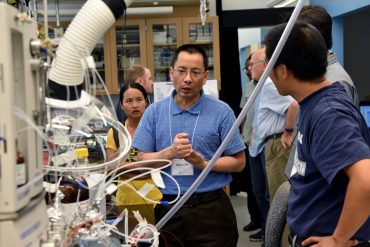
Aug. 15, 2016
Research Core offers new capabilities
Grand opening highlights specialty of large-scale metabolite profiling By Phillip Sitter | Bond LSC Dr. Zhentian Lei , assistant director and assistant research professor of the MU Metabolomics Center, provides an overview of an ultra high-pressure liquid chromatograph coupled to mass spectrometry for the large-scale profiling of metabolites at the University of Missouri Metabolomics Center open house on Aug. 12. | photo by Zivile Raskauskaite, Bond LSC You might think you’ve entered the inside of a pinball machine for a moment when you enter lab 243 at the Bond Life Sciences Center. But the wires…
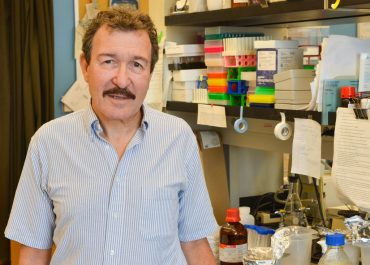
Aug. 4, 2016
Standing out through saliva
Bond LSC scientist internationally recognized for work on salivary glands and autoimmune disorders By Phillip Sitter | Bond LSC You might not think too highly of spit, but you would quickly regret not having any. People with Sjögren’s syndrome suffer chronic dry mouth and eyes from an overzealous immune system that attacks salivary and tear ducts, causing serious health issues. Gary Weisman’s research might hold the key to understanding and managing this immune response, leading to effective treatment or even prevention of this ailment. For this, the International Association of Dental Research, or IADR, awarded him the 2016 Distinguished Scientist Award…
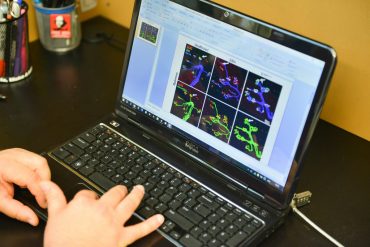
July 21, 2016
Finding hope by fixing a gene
Lorson lab publishes research on a new therapeutic path to help treat spinal muscular atrophy By Phillip Sitter | MU Bond Life Sciences Center Erkan Osman shows iImages of neuro-muscular junctions. Osman, a post-doctoral fellow in Chris Lorson’s lab, co-authored research in the journal Molecular Therapy that details work in binding a synthetic nucleic acid to a normally useless motor neuron backup gene to help treat spinal muscular atrophy. | photo by Phillip Sitter, Bond LSC Imagine you are forced to jump out of an airplane. Luckily, you find a parachute that even…
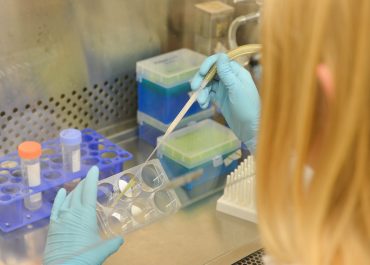
July 19, 2016
How does Zika move from mother to child?
Scientists use placental cells in lab to study virus By Phillip Sitter | MU Bond Life Sciences Center Megan Sheridan, an MU grad student, removes the base solution from a demonstrated sample of stem cells that will be grown into placental cells for study of Zika virus. Within four days of exposure to the correct hormones, the stem cells express genes of placental cells, and within another day start producing placental hormones. The cells are infected with Zika at day four to ensure maximum measurable interaction, as the stem cells naturally die in…
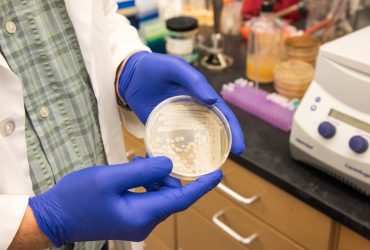
July 6, 2016
Anthrax: villain or misunderstood?
Stewart holds a different colony of anthrax in his lab. Stewart’s work with anthrax and other similar organisms focuses on understanding the tough protein shell of the bacteria’s spores that enable the pathogen to survive in soil for extended periods of time, even hundreds of years. | photo by Phillip Sitter, Bond LSC By Phillip Sitter | MU Bond Life Sciences Center For a tiny spore, anthrax holds a lot of danger and promise. If you found yourself wondering about more than its safety in the lab, we have a answers to a few persistent…
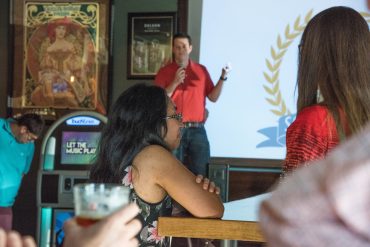
June 29, 2016
Science on Tap CoMo serves up food for thought while you drink
Grad students present brain science, crop biology research in series kick-off By Phillip Sitter | MU Bond Life Sciences Center University of Missouri PhD student in biological sciences Nat Graham introduces the first Science on Tap CoMo event on the evening of Tuesday, June 28 at Ninth Street Public House. | photo by Phillip Sitter, Bond LSC You never know what conversations you might overhear at a bar. The talk centered on neural proteins and vitamin A-fortified bananas Tuesday night as about 40 science-minded people met at 9th Street Public House for the first Science on…
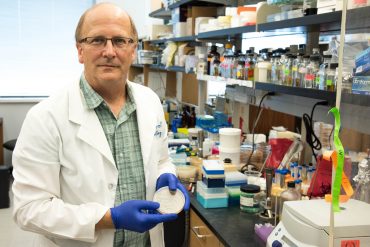
June 29, 2016
Under the hood
The safety behind studying deadly disease By Phillip Sitter | MU Bond Life Sciences Center George Stewart, McKee Professor of Microbial Pathogenesis and Chair of Veterinary Pathobiology holds up a colony of Bacillus anthracis in his lab. The strain of anthrax he holds is non-virulent, and is therefore safe to handle under BSL-2 precautions as opposed to BSL-3 for virulent strains that cause disease in humans. | photo by Phillip Sitter, Bond LSC You’ve seen it before in the movies. Sweaty scientists put on their full-body, spacesuit-like get-ups to stave off a potentially extinction-level…

June 28, 2016
Symposium brings Columbia together around protecting native pollinators
By Zivile Raskauskaite | MU Bond Life Sciences Center The Mizzou Botanic Garden organized Native Pollinators Symposium in Columbia as a part of National Pollinators’ Week, which runs June 20-26. | photo by Zivile Raskauskaite, Bond LSC While walking through the A.L. Gustin Golf Course in Columbia you might be surprised by blossoms of milkweed or wild bergamot. While some golfers consider it a pests, golf course superintendent Isaac Breuer said properly managed wildflowers in the golf course turned into an important sanctuary for pollinators, such as bees, birds and butterflies.
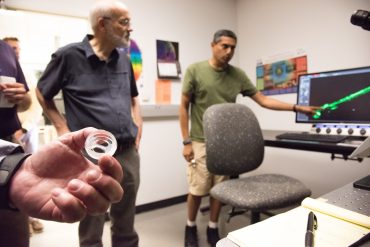
June 23, 2016
More than meets the eye
Molecular Cytology Core magnifies scope of research By Phillip Sitter | MU Bond Life Sciences Center A sample is shown in the foreground that can be used in the digital light sheet microscope at MU’s Molecular Cytology Core as Anand Chandrasekhar explains how he uses it to study neuronal development in zebrafish. | photo by Roger Meissen, Bond LSC Microscopes have come a long way since Anton van Leeuwenhoek first looked at single-cell organisms in the 1600s. Now, cutting-edge microscopes allow scientists a better look at how cells interact and work. The results were easy to…
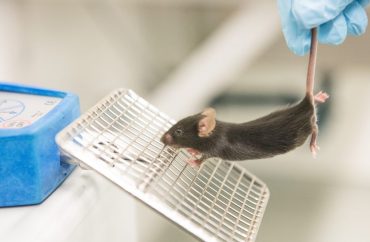
May 23, 2016
One step closer from mice to men
Gene therapy treating the neurodegenerative disease, SMARD1, shows promising results in mice studies. Shababi uses an instrument to measure grip strength in the forelimbs of mice. Healthy mice are able to cling on with a stronger grip than SMARD1 mice. | photo by Jennifer Lu, Bond LSC Monir Shababi was confident her experiments treating a rare genetic disease would yield positive results before she even ran them. Scientists had success with a similar degenerative neuromuscular disease, so she had every expectation their strategy would work just as well in her mice. Monir…
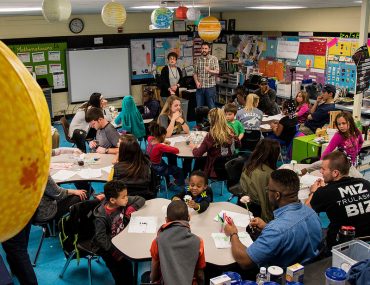
May 2, 2016
Learning on Different Levels
New outreach program teaches CAFNR students to make plant science knowledge accessible to a younger audience Written by Stephen Schmidt | Science Writer in the College of Agriculture, Food and Natural Resources Although abundant light was shining through the windows, it was the quiet before the storm. Andrew Ludwig, a University of Missouri sophomore majoring in plant sciences, surveyed the small tables and chairs spread out before him in the laboratory of the Benton STEM Elementary School on a recent Monday afternoon. He sifted through his notes. He was ready, even though it was his first time stepping foot…
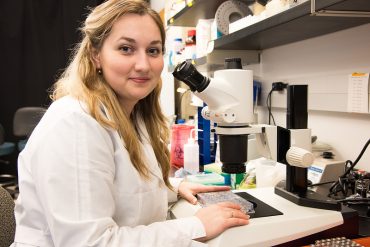
April 5, 2016
Gres receives Von Schwedler Prize
Work on HIV capsid proteins earns prestigious retrivology award Anna Gres studies HIV capsid protein using X-ray crystallography. She recently won the 2016 von Schwedler Prize, which awards her $1,200 and gives her the oppportunity to speak this spring at the Cold Spring Harbor Retrovirus Meeting, one of the largest retroviral research conferences in the world. | photo by Roger Meissen, Bond LSC Science is all about structure in the work of Anna Gres. For the past four years, she’s looked closely at one HIV protein to figure out its shape in order to stop the virus.